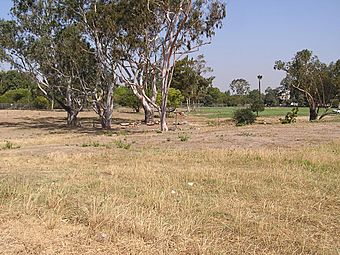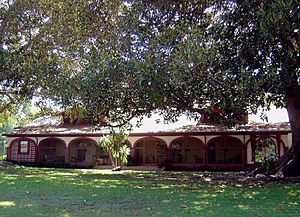Puvunga facts for kids
|
Puvunga Indian Village Sites and Boundary Increase
|
|

The Puvunga site on the campus of Cal State Long Beach
|
|
| Nearest city | Long Beach, California |
|---|---|
| Architect | Tongva |
| NRHP reference No. | 74000521 (original) 82000429 (increase) |
Quick facts for kids Significant dates |
|
| Added to NRHP | January 21, 1974 |
| Boundary increase | May 22, 1982 |
Puvunga (also spelled Puvungna or Povuu'nga) is an ancient village and a very special, sacred place. It belongs to the Tongva nation, who are the original people of the Los Angeles Basin. It is also important to the Acjachemen, who are the original people of Orange County. Today, this site is found within the California State University, Long Beach campus and nearby areas. The Tongva people call Puvunga the "place of emergence." They believe it is where their world and their lives first began. Puvunga is a key ceremonial site. It is also the end point of a yearly journey, called a pilgrimage, for the Tongva, Acjachemen, and Chumash tribes.
Long ago, before European settlers arrived, Puvunga was much larger than the small area that remains today. Its existence was first discovered in 1952. More was found in 1974 when digging happened for the Earl Burns Miller Japanese Garden. The site was officially added to the National Register of Historic Places in 1974. In 1992, the university tried to build a shopping center on the site. This plan was stopped by protests and help from the ACLU. In 2019, the university dumped dirt and trash on the site, which caused more problems.
The site is located near the Japanese Garden. It sits along a creek, which is now a channel. This spot is about three miles (5 km) from the Pacific Ocean. The natural area is close to a parking lot on the edge of the campus. There used to be a natural spring nearby, called Puvunga Spring, which flowed until 1956. Another similar, but larger, Tongva site is Kuruvungna Springs. This one is on the grounds of University High School in Los Angeles.
Contents
What Does Puvunga Mean?
The name Puvunga can have different meanings. Some say it means "the place of the gathering." Others believe it means "in the ball." The meaning depends on the historical source.
Why Puvunga Is Important
Puvunga has been on the National Register of Historic Places since 1974. This shows its great historical and cultural importance. It is still a special place for ceremonies for the Acjachemen, Tongva, and Chumash tribes. They gather there for important events. Puvunga is also the final stop for a yearly pilgrimage. This journey starts at another village site called Panhe, which is now in San Onofre.
The Tongva and Acjachemen people remember Puvunga as the home of Wiyot. Wiyot was one of their First Beings and a sacred leader. They call Puvunga "the place of emergence." It is where they believe their world and lives began. In Tongva stories, Puvunga is also the birthplace of Chingishnish. He was a prophet or god who appeared after Wiyot died. Chingishnish told the people what they needed to do to survive. Rare bird species have also been seen at the site by the Audubon Society.
Puvunga's History
A Center for Trade and Ceremonies

Puvunga used to be on a small hill. This hill overlooked the huge wetlands of the San Gabriel River. These wetlands are now known as the Los Cerritos Wetlands. The Pacific Ocean once reached the edge of the village. However, settlers and building projects have pushed the ocean several miles west.
Puvunga was a very large village. It stretched far beyond the small area that remains today. It was a major center for trade and ceremonies for the Tongva and Acjachemen people. Villagers used special canoes called te'aats. They traveled on important journeys to villages on Pimu (Santa Catalina Island) and other islands. These islands are now called the Channel Islands.
Other villages were located nearby along the coast. These included Motuucheyngna (at modern-day Seal Beach). This site is sometimes called Puvungna East by archaeologists. There was also Guashna (now at Playa Vista), about twenty miles up the coast. And the village of Lupukngna was located down the coastline, at the mouth of the Santa Ana River.
European Arrival and Changes

Like many other Tongva villages, life at Puvunga changed greatly when Spanish missionaries and soldiers arrived. The Mission San Gabriel was built in 1771. Many people from surrounding villages were brought there. They were converted to Christianity and forced to work. They labored on the mission grounds in very harsh conditions. Between 1785 and 1805, mission records show many baptisms of villagers from Puvunga. This suggests the village likely became empty soon after.
In 1822, a person named Geronimo Boscana mentioned the village as Pubuna. He said it was located within the Spanish land grant Rancho Los Nietos. This grant was created in 1784. Many villagers likely died at the mission. Many did not survive this mission period. At Mission San Gabriel, there were 7,854 baptisms and 5,656 deaths until 1834. This shows a very high death rate. Children often died very young at the missions. One missionary reported that three out of every four children born died before age two.
In 1844, Hugo Reid referred to the village as Pubugna. He stated it could still be found at Rancho Los Alamitos. This was a smaller part of Rancho de los Nietos. John Peabody Harrington later found evidence of ancient shell piles in the Rancho Los Alamitos area. He spoke with three Indigenous people. They all identified the site in Los Alamitos as the village. They called it "Puvu'na" or "Puvu." Harrington's report was published in 1933.
Building and Recognition
In June 1950, the City Council of Long Beach bought 320 acres of land. This land included a large part of the historical village of Puvunga. It was used to build the campus of California State University of Long Beach. On Christmas Eve of 1952, an ancient burial site was found. It was about a mile north of the campus. Workers found two dozen ancestral remains and special objects. An article in 1952 suggested these "ruins might be part of Pubunga, an ancient 'holy city.'"
In 1955, Helen Smith Giffen noted that shell pieces were scattered in the fields below the Los Alamitos ranch house. This showed it was once an Indian village, Puvunga. She also mentioned a "wonderful spring" that still flowed there. On the first Earth Day celebration, organic gardens were started on 22 acres of Puvunga. This land was still undeveloped and open to the public. The garden was used to grow food.

In 1972, campus workers found parts of a burial site. This was at site LAn-235 on the western edge of campus. Money for digging in 1973 came from the City of Long Beach and other groups. Tongva items found included arrowheads and pieces of pottery. These items were placed in the university's archaeology lab.
Archaeologists wrote in 1974 that the Tongva "suddenly left the site in the early 1800s." This was just before the first white family took over the land. That same year, LAn-235 was added to the National Register of Historic Places. This was to remember these native peoples and their beliefs. Two other sites were also included: LAn-234 and LAn-306. These are located just east of campus at the historic Rancho Los Alamitos.
In 1979, a person's remains, found in 1972, were reburied. After this, campus workers put up a small wooden sign. It read: "Gabrieleno Indians once inhabited this site, Puvunga, the birthplace of Chungicnish, law-giver and god." More than a dozen ancient sites have been found. They cover about 500 acres on and near the campus. These are all part of the Puvungna village sites. Today, a shopping center, apartments, a hospital, Rancho Los Alamitos, and the college stand on top of this historic settlement.
Protecting Puvunga: Challenges and Efforts
Even though Puvunga is culturally important, the university tried to build a shopping center there in 1992. They also planned to build over a community garden. Gardeners protested, but campus officials ignored them. They claimed there were "no cultural resources" on the site.
In response, the Tongva people and others worked together to stop the building. They held protests and filed a lawsuit. This temporarily stopped any construction. The university's change in attitude was due to new leadership. Also, California was giving less money to public education. This pushed universities to find other ways to make money.
People took direct action to protect the site. They set up protest tents and held prayer gatherings. The university then put a fence around the area. They ordered protestors to leave or face arrest. This led the American Civil Liberties Union (ACLU) to get involved. The ACLU filed a legal order against the university. An ACLU representative said, "This case is about the First Amendment rights of the Native Americans to whom Puvungna is sacred. They have the right to freely exercise their beliefs without the state stepping in to pave over their place of worship and put a mini-mall on it." A short film about these events, called Sacred Lands, White Man's Laws, was released in 1994.
In 1995, Robert Maxson became the university's President. He promised to stop all building plans on the land. He also pledged to keep it as open space as long as he was President. He kept his promise until he left office in 2006.
Another ancient burial site in the Puvunga area was disturbed. This happened during the building of the Hellman Ranch neighborhood in Seal Beach. This site is sometimes called Puvungna East. About 35 bodies were disturbed during this building. Many Tongva artifacts were also found.
In 2019, the university faced criticism for dumping dirt and trash on the site. Local Indigenous groups, like the Juaneño Band of Mission Indians, were not asked about the dumping. This led to a legal challenge by the tribe. It stopped the dumping in October 2019. The legal process was delayed because of the COVID-19 pandemic. The tribe's chairman, Matias Belardes, said the dumping was disrespectful. He felt it showed a step backward after years of better understanding. He said, "We thought we were past it already. It shouldn't have come to this. The university should know the site's significance." In response, six university departments are creating films and educational materials. They want to teach the campus community about the site's importance. This aims to prevent future damage.
In August 2020, the California Office of Historical Preservation criticized the university for damaging the site. In January 2021, the university president said rumors of building on Puvungna were false. However, a report three months later showed the university did plan to build another parking lot there. That same month, many groups and tribes sent a letter to Governor Gavin Newson. They asked him to protect Puvungna. In August 2021, the Native American Heritage Commission started an official investigation. One month later, a settlement was reached. This agreement stops building on the land. It also allows tribal nations to use Puvungna for their traditional activities. The university is not responsible for removing the construction debris under this agreement.
|




